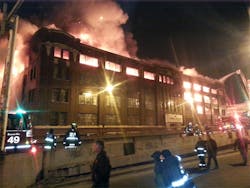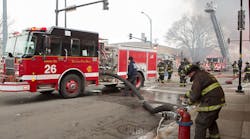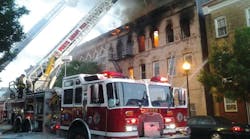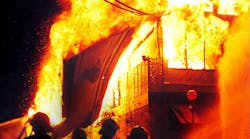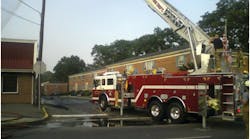Jan. 23--One-third of the Chicago Fire Department's on-duty personnel responded to a 5-11 alarm fire that engulfed a warehouse building, causing parts of it to collapse and endangering nearby buildings in the Bridgeport neighborhood Tuesday night.
A four-story building caught fire after 9 p.m., endangering another building, according to the Chicago Fire Department. Extra alarms, bringing more fire equipment, firefighters and paramedics were called soon after firefighters arrived. The fire in the former Harris Marcus Group building, 3757 S. Ashland Ave., was declared under control, though still burning, as of about 12:30 a.m. Wednesday.
Firefighters had to contend with frozen hydrants and ice caused by overspray, Fire Department Commissioner Jose Santiago said. One firefighter suffered a back injury and was taken to Advocate Christ Medical Center in serious condition, said Chicago Firefighter Meg Ahlheim, a department spokeswoman.
The fire climbed into the sky and sent ashes down on cars below. The warmth from the blaze could be felt blocks away. A Chicago Fire Department helicopter was called into service to provide an "aerial visual," but after firefighters arrived, they were able to keep the blaze from spreading to nearby businesses, Santiago said.
Still, anyone who looked out an upper-floor window from buildings across the city could see the fire, with many sending photographs out over social media. Ashes fell far from the fire scene.
"You could see the embers from the highway," said Darcy Benedict, a 28-year-old UIC medical school student. "I could see blue flames rising up."
Benedict and her boyfriend saw the fire from Interstate 55 and got off to get a better look.
A crowd of at least 40 adults and children stood behind police tape, bundled up in the freezing weather, taking videos with cellphones.
Several others at the scene expressed doubt that the fire could be contained, as dozens of hoses could be seen in the distance spraying high and low onto the enormous blaze.
The commander at Tuesday's fire used two 'special alarms' to call for additional equipment beyond what a 5-11 alarm calls for, calling in special equipment needed to fight the massive blaze, Santiago said.
"I'm looking at the south side of the main fire building and there's a big portion of exterior wall and roof collapse," said Chicago Firefighter Meg Ahlheim, a Chicago Fire Department spokeswoman.
There was "extreme fire" throughout the buildings. Nobody has been reported injured.
The fire in the second building was mostly extinguished as of about 10:25 p.m. but the first building is "still involved," Ahlheim said.
Special alarms are called beyond the fifth, though they are "extremely rare," according to the fire department.
Commissioner Santiago said it was the first time a 5-11 with two special alarms was called since 2006 -- apparently fire a fire that gutted the historic Wirt Dexter Building in the South Loop. That fire broke out before 3 p.m. on a weekday, snarled downtown traffic and forced the CTA to stop service on Loop L tracks.
Santiago said a Fire Department chief was driving past the warehouse when he saw smoke, turned around and called the fire in, bringing the first response, which was quickly elevated to an extra-alarm.
The alarms normally escalate one at a time beyond a normal fire response up to a fifth alarm, though the scene commander skipped a fourth alarm once the fire jumped to another building.
There was also a 5-11 fire in 2012 -- in Avondale on the Northwest Side. That burned for hours but didn't required the special alarms called for Tuesday night's fire. About 200 firefighters and paramedics responded to that fire.
Santiago described the warehouse as "old," with lots of timber throughout the building. Firefighters are expected to be at the blaze for several hours, he said. As the water poured on the fire starts to freeze, more portions of the timber-and-brick construction building are likely to collapse under the weight of the ice, he said.
Check back for more information.
Twitter: @ltaford
Twitter: @peternickeas
Twitter: @ellenjeanhirst
Copyright 2013 - Chicago Tribune
